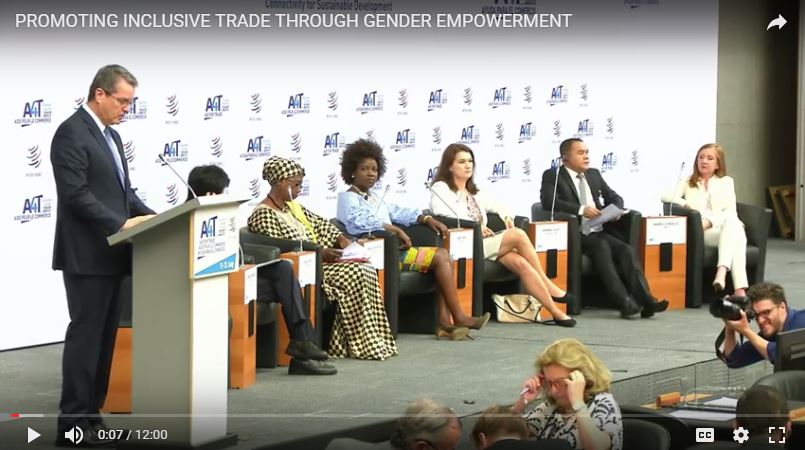Women and trade
Empowering women through Aid for Trade
The final report of the Aid for Trade Task Force, created in 2006, provides a clear mandate for gender equality to be included in the Aid for Trade initiative: “Aid for trade should be rendered in a coherent manner taking full account … of the gender perspective and of the overall goal of sustainable development…. Donors and partner countries jointly commit to the harmonization of efforts on cross-cutting issues, such as gender."
Subsequent Aid for Trade global reviews have highlighted a broad range of areas in which Aid for Trade has had a positive impact on women's economic empowerment.
Case stories have illustrated how the Aid for Trade initiative has helped to increase employment opportunities for women and has helped women to access finance and to participate in global supply chains.
Since 2011, there has been a growing focus on women's economic empowerment through the monitoring and evaluation of the Aid for Trade initiative, in Geneva-based workshops on Aid for Trade, in outreach activities and at the biennial global reviews of Aid for Trade.
Global reviews
Women's empowerment was specifically addressed at the 4th Global Review of Aid for Trade in 2011. A number of case stories submitted in response to the Monitoring Exercise highlighted efforts to improve women's economic empowerment through trade capacity building. A workshop was organised on this topic in 2011 in preparation of the 4th Global Review.
At the 5th Global Review of Aid for Trade in 2015, the WTO and World Bank Group launched “The Role of Trade in Ending Poverty”, which included a chapter on "Women, Trade and Poverty. The publication highlights the gender dimension of extreme poverty. It also analyses how integration into global trade can positively impact women's economic empowerment.
The 2015 call for case stories included many studies reporting how Aid for Trade has helped to improve employment opportunities for women. The 5th Global Review also included a plenary session on trade and gender - "Empowering Women through Inclusive Value Chains" - and a side event hosted by the Swedish Government on "Barriers Facing Women Traders in Africa: What are They and How Could Aid for Trade Help in Removing Them?"
The theme of the Global Review in 2015, "Reducing Trade Costs for Inclusive, Sustainable Growth", was another opportunity to elaborate on gender inequalities in international trade. One conclusion from the analysis was that high trade costs have a significant impact on least-developed countries, particularly on women traders and on small and medium-sized enterprises, pricing them out of international trade.
Aid for Trade Work Programme 2016-17
Gender was a cross-cutting issue in the Aid for Trade Work Programme for 2016-17. The monitoring and evaluation exercise revealed that 38% of the surveyed developing countries and 50% of Aid for Trade donors considered that Aid for Trade can help achieve Sustainable Development Goal 5 on gender equality. A total of 87% of Aid for Trade donors have integrated women's economic empowerment into their Aid-for-Trade programmes.
Women’s economic empowerment was a particular focus of the Aid for Trade Global Review 2017, with a number of sessions dedicated to gender issues. At the Review, donors and developing partners discussed how to increase their focus on women's empowerment and how Aid for Trade impacts women. A number of key messages were voiced:
- Women are important for countries' economic growth and development. Gender equality is key to ending extreme poverty and fostering sustainable growth.
- Countries need to recognize women's role and potential as entrepreneurs and should facilitate their access to finance. Women are “completely in the background”, even though women entrepreneurs have a 98% repayment rate for loans.
- It is important to bridge the digital divide for women. The share of women accessing the Internet is 12% less than the share of men accessing it. The smallest digital gender divide is in the Americas (2%), the largest is in Africa (23%) and in least-developed countries (31%).
- Textile, agriculture, fisheries and tourism are sectors where women are the most active.
Other sessions on gender in Aid for Trade global reviews
11 July 2017 |
||
12 July 2017 |
Plenary Session: Promoting Inclusive Trade through Gender Empowerment Closing the Digital Gender Divide. Organizers: eTrade for All, GSMA |
|
2 July 2015 |
Trade and Gender: Empowering Women through Inclusive Supply Chains |
|
|
Share
Problems viewing this page? If so, please contact [email protected] giving details of the operating system and web browser you are using.
